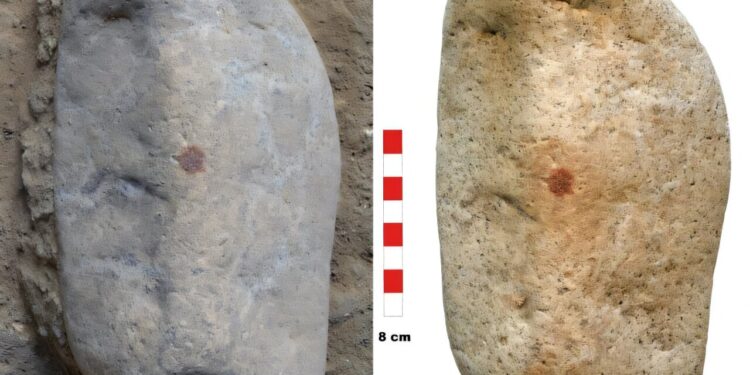The object before being completely searched; B. Once discovered, it is possible to assess the three main cavities and the central position of the red dot. Credit: Archaeological and anthropological sciences (2025). DOI: 10.1007 / S12520-025-02243-1
In the depths of the San Lázaro Rock-Shelter in Segovia, in the center of Spain, archaeologists from the complutense university of Madrid and collaborators discovered a convincing trace of neatertal symbolic imprint: a granite stone marked by pigments bearing above all a human fingerprint, and the deliberate placating of the Red Red Curf in the relationship with three natural actors, Creation of the manner of potential.
Neanderthal symbolic behavior was one of the most controversial subjects in prehistoric times. A large part of the allegedly symbolism debate is exclusive to Homo Sapiens. The ability to transmit meaning through marks, symbols and images has often been considered a key distinction that cognitively separated modern humans from our ancient evolutionary cousins.
An increasing number of symbolic artefacts and paints of caves, including those of the Maltravieso caves and the Pasiega of Spain, formerly considered as modern human works, are now attributed to Neanderthals.
In the study, “more than a fingerprint on a pebble: an object marked pigment of San Lázaro Rock-Shelter in the context of Neanderthal symbolic behavior”, published in Archaeological and anthropological sciencesThe researchers designed a multi-method survey to determine if a granges of granite found in the Mousterian layer had been intentionally marked with ocher.
Excavated during the 2022 season from a non -disturbed moustterian stratum dated approximately 43,000 years before the presence, the rock of the Granit river measures 21.4 × 11.3 × 7.6 cm and was different from the smallest Hammerstones found in the same context. It was out of connection with a geological context of a rock of the lonely river in a cave, then, to make it even more aberrant, it was painted with a single visible red dot of ocher.
A. View of San Lázaro Rock Shelter during the excavations. B. San Lázaro Rock Shelter at the end of excavation 2022. Credit: Archaeological and anthropological sciences (2025). DOI: 10.1007 / S12520-025-02243-1
It includes three indentations, two small and symmetrical, one larger and irregular, framing a central red point. The placement of the point in relation to indentations gives the impression of a symbolic face. It is a bit of guardian, not a well -executed sculpture or engraving, and it is unlikely that it triggers facial recognition of Pareidolia at first glance.
But there was enough evidence of the intention that the researchers had to pay particular attention to the details which could otherwise be missed.
First, the point of the red ocher placed central on the surface of the stone was not a natural event. The little art of the Neanderthal cave is known to science was often painted with this pigment and frequently included assemblies of points.
Then the stone itself was unusual. The researchers concluded that the artifact was not used for the manufacture of tools, no wear brands or abrasions was present, and its size and morphology go away from all the known utility stones of the same level. While some of the characteristics of indentations seem natural, some show signs of subtle manipulation.
It is made up of granite rich in quartz, geologically rare in the immediate area of the site, but naturally present in sections upstream of the Eresma river, about 5 km from the site. The analysis of the areas has excluded a natural deposit of a single river rock, and it must therefore have been transported to the distance in the hand of a Neanderthal.
And finally, when looked at from the point of view of it being an intentional object without utilitarian function and both physical and decorative manipulation, facial features can start to emerge.
A large part of this interpretation depends on the hypothesis of intentionality. To determine whether the ocher brand was natural, accidental or symbolic, the team used a range of analytical tools.
Dermatoglyphic image obtained by multispectral analysis of the red point. Credit: Archaeological and anthropological sciences (2025). DOI: 10.1007 / S12520-025-02243-1
A 3D laser scan documented by microtopography, the electron scanning microscopy (SEM) has identified the ocher as an applied iron oxide without any liaison agent, and multispectral imaging revealed a dermatoglyphic motif in the pigment later confirmed by medical -legal analysts – a human fingerprint, with a ridge morphology, bifurcations and points Converrence.
Statistical modeling has excluded random placement. The simulations of Monte Carlo gave only 0.31% chance that the equidistant relationship of the red dot with the two symmetrical indentations occurred by chance. The red point therefore seems intentionally placed on a carefully selected surface, potentially to evoke a specific image.
That future discoveries confirm this interpretation, the San Lázaro Pebble is now among a selected group of Neanderthal artifacts: walls of painted caves, engraved bones and modified greenhouses, which forced a cognitive re -evaluation of what it meant in a human being in a world without homo sapiens.
More information:
David Álvarez-Onso et al, more than a fingerprint on a pebble: an object marked by the pigments of San Lázaro Rock-Shelter in the context of Neanderthal symbolic behavior, Archaeological and anthropological sciences (2025). DOI: 10.1007 / S12520-025-02243-1
© 2025 Science X Network
Quote: A red point, a 43,000 -year -old digital imprint and a stone out of words – potential evidence of Neanderthal Pareidolia (2025, May 28) recovered on May 29, 2025 from
This document is subject to copyright. In addition to any fair program for private or research purposes, no part can be reproduced without written authorization. The content is provided only for information purposes.



